Lincoln Cathedral
Lincoln Cathedral, also called Lincoln Minster and formally the Cathedral Church of the Blessed Virgin Mary of Lincoln, is a Church of England cathedral in Lincoln, England. It is the seat of the bishop of Lincoln and is the mother church of the diocese of Lincoln. The cathedral is governed by its dean and chapter, and is a grade I listed building.
The earliest parts of the current building date to 1072, when bishop Remigius de Fécamp moved his seat from Dorchester on Thames to Lincoln. The building was completed in 1092, but severely damaged in an earthquake in 1185. It was rebuilt over the following centuries in the Gothic style. The cathedral became the tallest building in the world upon the completion of its 160-metre-high (525 ft) central spire in 1311. It surpassed the Great Pyramid of Giza, and held the title until the spire collapsed in 1548 and was not rebuilt.
The cathedral holds one of the four remaining copies of ...Read more
Lincoln Cathedral, also called Lincoln Minster and formally the Cathedral Church of the Blessed Virgin Mary of Lincoln, is a Church of England cathedral in Lincoln, England. It is the seat of the bishop of Lincoln and is the mother church of the diocese of Lincoln. The cathedral is governed by its dean and chapter, and is a grade I listed building.
The earliest parts of the current building date to 1072, when bishop Remigius de Fécamp moved his seat from Dorchester on Thames to Lincoln. The building was completed in 1092, but severely damaged in an earthquake in 1185. It was rebuilt over the following centuries in the Gothic style. The cathedral became the tallest building in the world upon the completion of its 160-metre-high (525 ft) central spire in 1311. It surpassed the Great Pyramid of Giza, and held the title until the spire collapsed in 1548 and was not rebuilt.
The cathedral holds one of the four remaining copies of the original Magna Carta, which is now displayed in Lincoln Castle. It is the fourth largest cathedral in the UK by floor area, at approximately 5,000 m2 (50,000 sq ft), after Liverpool Cathedral, St Paul's Cathedral, and York Minster. It is highly regarded by architectural scholars; the Victorian writer John Ruskin declared: "I have always held ... that the cathedral of Lincoln is out and out the most precious piece of architecture in the British Isles and roughly speaking worth any two other cathedrals we have."
The first Bishop of Lincoln Remigius de Fécamp moved the episcopal seat (cathedra) there "some time between 1072 and 1092".[1] About this, James Essex writes that "Remigius ... laid the foundations of his Cathedral in 1072" and "it is probable that he, being a Norman, employed Norman masons to superintend the building ... though he could not complete the whole before his death."[2]
Before that, writes B Winkles, "It is well known that Remigius appropriated the parish church of St Mary Magdalene in Lincoln, although it is not known what use he made of it."[3]
When Lincoln Cathedral was first built, William the Conqueror granted the parish of Welton to Remigius in order to endow six prebends which provided income to support six canons attached to the cathedral. These were subsequently confirmed by William II and Henry I.[4]
 Model within the cathedral illustrating the cathedral's former spires
Model within the cathedral illustrating the cathedral's former spires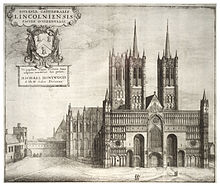 17th century print of Lincoln Cathedral with spires on the west towers
17th century print of Lincoln Cathedral with spires on the west towersUntil then St Mary's Church in Stow was considered to be the "mother church"[5] of Lincolnshire[6] (although it was not a cathedral, because the seat of the diocese was at Dorchester Abbey in Dorchester-on-Thames, Oxfordshire). However, Lincoln was more central to a diocese that stretched from the Thames to the Humber.
Remigius built the first Lincoln Cathedral on the present site, finishing it in 1092 and then dying on 7 May of that year,[7] two days before it was consecrated. In 1124, the timber roofing was destroyed in a fire. Alexander (bishop, 1123–48) rebuilt and expanded the cathedral, but it was mostly destroyed by an earthquake about forty years later, in 1185 (dated by the British Geological Survey as occurring 15 April 1185).[3][8] The earthquake was one of the largest felt in the UK: it has an estimated magnitude of over 5. The damage to the cathedral is thought to have been very extensive: the cathedral is described as having "split from top to bottom"; in the current building, only the lower part of the west end and its two attached towers remain of the pre-earthquake cathedral.[8]
Some (Kidson, 1986; Woo, 1991) have suggested that the damage to Lincoln Cathedral was probably exacerbated by poor construction or design, with the actual collapse most probably caused by a vault failure.[8]
After the earthquake, a new bishop was appointed. He was Hugh de Burgundy of Avalon, France, who became known as St Hugh of Lincoln. He began a massive rebuilding and expansion programme. With his appointment of William de Montibus as master of the cathedral school and chancellor, Lincoln briefly became one of the leading educational centres in England, producing writers such as Samuel Presbiter and Richard of Wetheringsett, though it declined in importance after William's death in 1213.[9] Rebuilding began with the choir (St Hugh's Choir) and the eastern transepts between 1192 and 1210.[10] The central nave was then built in the Early English Gothic architectural style. Lincoln Cathedral soon followed other architectural advances of the time – pointed arches, flying buttresses and ribbed vaulting were added to the cathedral. This allowed support for incorporating larger windows. There are thirteen bells in the south-west tower, two in the north-west tower, and five in the central tower (including Great Tom). Accompanying the cathedral's large bell, Great Tom of Lincoln, is a quarter-hour striking clock which was installed in the early 19th century.[11] The two large stained glass rose windows, the matching Dean's Eye and the Bishop's Eye were added to the cathedral during the late Middle Ages. The former, the Dean's Eye in the north transept dates from the 1192 rebuild begun by St Hugh, completed in 1235. The latter, the Bishop's Eye, in the south transept was reconstructed a hundred years later in 1330.[12] A contemporary record, "The Metrical Life of St Hugh", refers to the meaning of these two windows (one on the dark, north, side and the other on the light, south, side of the building):
"For north represents the devil, and south the Holy Spirit and it is in these directions that the two eyes look. The bishop faces the south in order to invite in and the dean the north in order to shun; the one takes care to be saved, the other takes care not to perish. With these Eyes the cathedral's face is on watch for the candelabra of Heaven and the darkness of Lethe (oblivion)."
 Main door of the cathedral
Main door of the cathedral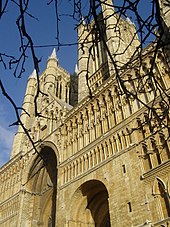 Norman West frontExternal videos
Norman West frontExternal videos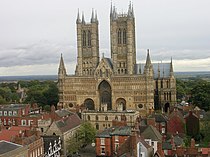
After the additions of the Dean's eye and other major Gothic additions it is believed some mistakes in the support of the tower occurred, for in 1237 the main tower collapsed. A new tower was soon started and in 1255 the cathedral petitioned Henry III to allow them to take down part of the town wall to enlarge and expand the cathedral, including the rebuilding of the central tower and spire. They replaced the small rounded chapels (built at the time of St Hugh) with a larger east end to the cathedral. This was to handle the increasing number of pilgrims to the cathedral, who came to worship at the shrine of Hugh of Lincoln.[ambiguous]
In 1290 Eleanor of Castile died and King Edward I of England decided to honour her, his Queen Consort, with an elegant funeral procession. After her body had been embalmed, which in the 13th century involved evisceration, Eleanor's viscera were buried in Lincoln cathedral and Edward placed a duplicate of the Westminster Abbey tomb there. The Lincoln tomb's original stone chest survives; its effigy was destroyed in the 17th century and replaced with a 19th-century copy. On the outside of Lincoln Cathedral are two prominent statues often identified as Edward and Eleanor, but these images were heavily restored in the 19th century and they were probably not originally intended to depict the couple.[14]
Between 1307 and 1311 the central tower was raised to its present height of 271 feet (83 m). The western towers and front of the cathedral were also improved and heightened. At this time, a tall lead-encased wooden spire topped the central tower but was blown down in a storm in 1548. Around 1380, the western towers were raised to their current height. [15] They were capped with wooden spires covered with lead in 1420, but by 1807 they were dismantled.[16] With its spire, the tower reputedly reached a height of 525 feet (160 m) (which would have made it the world's tallest structure, surpassing the Great Pyramid of Giza, which held the record for almost 4,000 years). Although still doubted,[17] this is the height agreed upon by the majority of historians.[18][19][20][disputed ]
Other additions to the cathedral at this time included its elaborate carved screen and the 14th-century misericords, as was the Angel Choir. For a large part of the length of the cathedral, the walls have arches in relief with a second layer in front to give the illusion of a passageway along the wall. However the illusion does not work, as the stonemason, copying techniques from France, did not make the arches the correct length needed for the illusion to be effective.[citation needed]
In 1398 John of Gaunt and Katherine Swynford founded a chantry in the cathedral to pray for the welfare of their souls. In the 15th century the building of the cathedral turned to chantry or memorial chapels. The chapels next to the Angel Choir were built in the Perpendicular style, with an emphasis on strong vertical lines, which survive today in the window tracery and wall panelling.
Magna CartaHugh of Wells, Bishop of Lincoln, was one of the signatories to Magna Carta and for hundreds of years the cathedral held one of the four remaining copies of the original, now securely displayed in Lincoln Castle.[21]
The Lincoln Magna Carta was on display at the British Pavilion during the 1939 New York World's Fair.[22] In March 1941, the Foreign Office proposed that the Lincoln Magna Carta be gifted to the United States, citing the "many thousands of Americans who waited in long queues to view it" and the US passage of the Lend-Lease Act, among other reasons.[22] In 2009 the Lincoln Magna Carta was lent to the Ronald Reagan Presidential Library in Simi Valley, California.[21]
There are three other surviving copies: two at the British Library and one at Salisbury Cathedral.[23]
Little Saint HughIn August 1255 the body of an eight-year-old boy was found in a well in Lincoln. He had been missing for nearly a month. This incident became the source of a blood libel in the city, with Jews accused of his abduction, torture, and murder. Many Jews were arrested and eighteen were hanged. The boy became known as Little Saint Hugh, to distinguish him from Saint Hugh of Lincoln, but he was never canonised.
The cathedral benefited from these events because Hugh was seen as a martyr, and many devotees came to the city and cathedral to venerate him. Geoffrey Chaucer mentions the case in "The Prioress's Tale" and a ballad was written about it in 1783. In 1955 a plaque was placed near "the remains of the shrine of 'Little St Hugh'" in the cathedral, that decries the "Trumped up stories of 'ritual murders' of Christian boys by Jewish communities."




























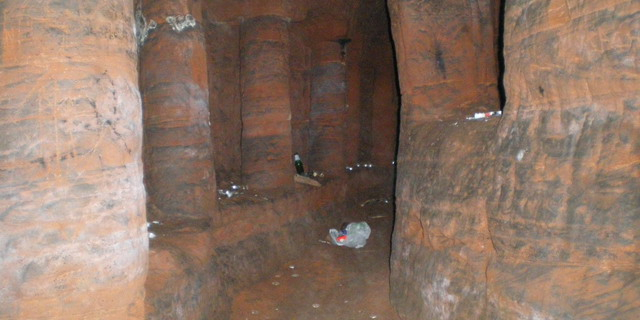




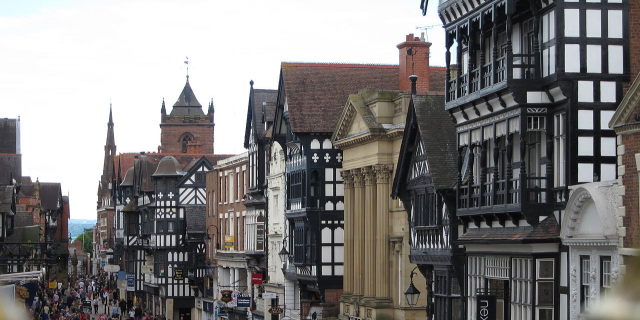



Add new comment